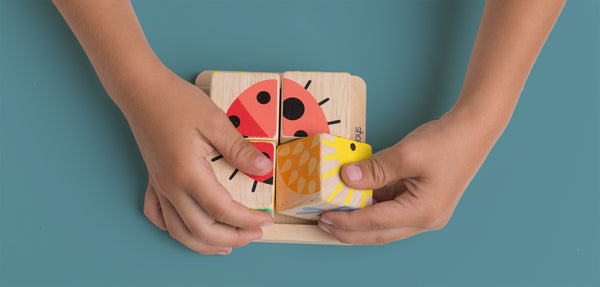Spatial reasoning: Unlock your child's potential in STEM and the visual arts

Do you remember doing non-verbal reasoning at school?
Here are four shapes. Which one of them is not a rotation of the shape on the left?
The test measures raw intelligence.
You can do it easily now but how did you get to be so good?
When you were a child you developed your spatial reasoning.
As a toddler you played with a shape sorter. Which way round must this shape go to fit through the hole? And then you moved on to puzzles and Lego and drawing.
And over time you mastered how shapes move in space. You got so good that you could do it in your mind without ever having to pick up the piece. You just knew if it would fit.
Spatial reasoning activities for preschoolers
Wooden building blocks
Building with blocks is a classic spatial reasoning activity that can help children develop their ability to visualize and manipulate objects in space. Give your child a variety of pieces. Each new shape offers its own possibilities and challenges.
Puzzles
Puzzles are another great way to develop spatial reasoning skills. Encourage children to work on jigsaw puzzles or shape puzzles, and to focus on visualizing the pieces and how they fit together.
Drawing
The draw-a-man test was an old-fashioned intelligence test. Can the child draw a stick man? Can she put all the features in the right place? Do the arms come out of the head or is there a discrete body? The test is now regarded as being overly simplistic but it contains a kernel of truth. To draw a man you have to notice. And that means you have to pay attention and hold several ideas in your head at once. Offer pencils and paper - or loose parts and arranging materials. Learn to arrange lines and objects in space. It’s great fun and a developmental superpower.
Treasure hunts
Where am I? How do I get from here to there? There’s nothing like reading a map to learn how to orientate yourself in space. With the reward of treasure at the end everyone is motivated to succeed!
Outdoor play
Outdoor play provides many opportunities for developing spatial reasoning skills, such as climbing, running, and jumping. Will I fit through that hole? Am I tall enough to reach those bars? Can I jump far enough to get across the gap? It’s all in a day’s fun when you play outside.
Origami and paper folding
Introduce your child to the art of paper folding. Origami helps develop spatial reasoning skills as children visualize and manipulate paper into different shapes and forms. Start with simple projects and gradually progress to more complex designs. This activity also enhances fine motor skills and creativity.
Tangrams and pattern blocks
These ancient Chinese puzzles consist of seven flat pieces (called "tans") that can be combined to create different shapes and figures. Encourage children to explore tangrams by recreating given designs or inventing their own. This activity promotes spatial reasoning and problem-solving skills. Similarly, pattern blocks can be used for constructing and exploring geometric shapes.
Spatial vocabulary development
Introduce and encourage the use of spatial vocabulary when talking with your child. Terms such as "above," "below," "next to," "inside," and "outside" help children better understand and express spatial concepts.
Constructing models and dioramas
Give your child the opportunity to create models or dioramas using a variety of materials, such as cardboard, pipe cleaners, and clay. Assembling models requires children to visualise and manipulate objects in space, boosting their spatial reasoning skills. Plus, it encourages creativity and patience.
Board games and strategy Games
Playing board games that involve spatial thinking, like chess, draughts, or Blokus, can help enhance a child's spatial reasoning skills. These games require players to consider the positioning of game pieces and plan moves ahead, strengthening their ability to visualise and manipulate objects in space.
Final word
Spatial reasoning is one of the building blocks of both writing and maths.
Make time for a variety of engaging activities, from puzzles and building blocks to origami and board games and your child will build a strong foundation in this essential cognitive skill.
Prepping for that non-verbal reasoning test isn’t hard. All you need is play.





